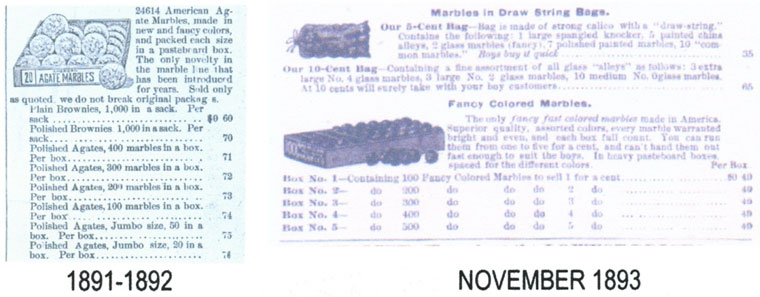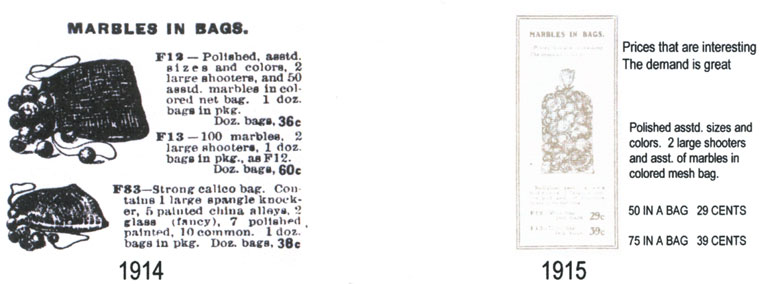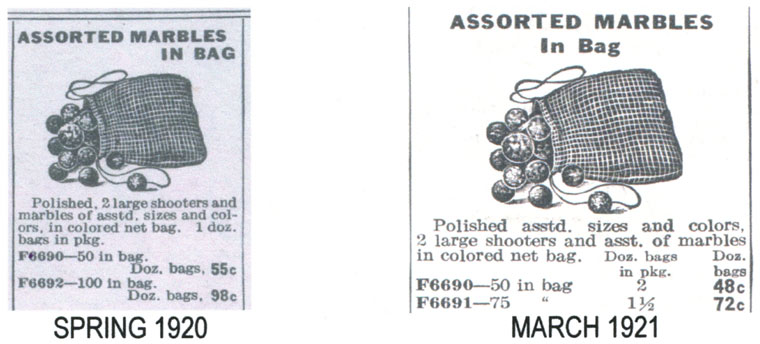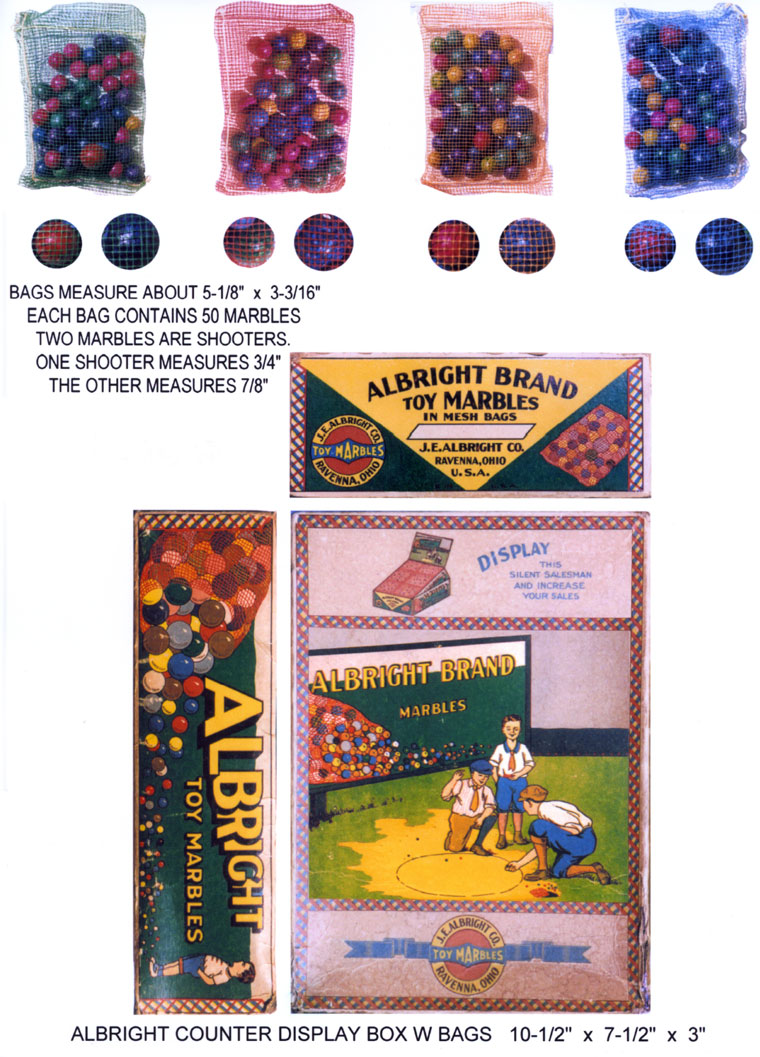

THE RISE AN FALL OF THE MESH BAG
By George Sourlis
In the winter of 1891-1892 in a

PLATE 1
The ad on the right in Plate 1 is from a wholesale catalog dated November
of 1893. A box and a drawstring bag
are pictured. The bag is described
as a strong calico bag. Calico is a
cotton fabric having randomly placed and oriented colorful prints.
Actually, 2 sizes of the calico bags are offered – a 35-count and a
65-count, each having an assortment of glass, china and clay marbles.
An identical calico bag ad was run in January of 1895, in spring of 1902,
and in the mid-winter of 1906. No
small boxes were offered in these ads.
1914 was a transition year.
The drawstring net (mesh) bag appeared and the calico drawstring bag persisted
(ad on the left in Plate 2). Two net
bags were offered – a 50-count and a 100-count.
Two marbles in each bag were large shooters.
The mesh was a fine mesh having threads space a about 10 to the inch.

PLATE 2
In the 1915 ad shown on the right in Plate 2 there are no calico bags.
Again there are 2 sizes of net bags, 25- and 75- count.
By the spring of 1920 the net bags had increased in size (left ad Plate
3) becoming 50- and 100-count bags.

PLATE 3
In March of 1921 net drawstring bags were available in counts of 50 and
75 marbles (ad on the right in Plate 3).
In the spring of 1922 manufacturers tried a new bag material, cambric
(fine linen), in their drawstring bags.
Two bag sizes were offered:
50-count and 100-count. By the fall
of that year the drawstring net bag was back in the same 2 sizes.
Apparently cambric was not as cost effective as the netting.
In 1923 the net bags lost their drawstrings (Plate 4).
The material was folded in half and sewn closed on two successive sides.
Marbles were inserted, and then the opening was sewn closed.
The description in the ad is more specific about the contents; the
50-count bag contained 48 9/16-inch marbles, one ¾-inch shooter, and one
7/8-inch shooter. For the first time
the net bags were called “MESH” bags.

PLATE 4
The closure of these bags by sewing and the specificity of the 2 shooter
sizes in the 50-count bags is strong evidence that these are the Albright
Company mesh bags shown with their large counter display box in Plate 5.

PLATE 5 ALBRIGHT COUNTER DISPLAY BOX W BAGS
From 1924 through 1931 sewn mesh bags dominated marble bag ads, but
occasionally an ad with a muslin drawstring bag appeared.
Ads for marbles in boxes by M. Gropper & Son, Akro Agate, and Christensen
Agate flourished.
In 1932 mesh bags saw two major changes.

PLATE 6
Between 1932 and 1935 mesh bags with labels popped up everywhere.
Akro introduced the Kings, Monarch, and Wizard bags.
Master Marble Company introduced a large and a small labeled mesh bag for
the 1933 World’s Fair. Then came
their Ritzy bag. Vitro presented the
Spinners, Sunny Boy, Seniors and Buddies bags.
In the same time period the mesh became coarser.
The early Albright sewn bags had about 10 threads per inch as did Berry
Pink’s double compartment bag. The
two Master Marble World’s Fair bags had about 8 threads per inch.
After 1935 mesh bags had only about 5 threads per inch (Plate 7).

PLATE 7
The design of mesh bags remained unchanged until the early 1950’s when
they disappeared completely. Akro,
which went out of business in 1951, used only mesh bags.
According to the new Vitro book, Vitro started using plastic bags in
1951. A 1953 Marble King ad shows
that they were using plastic bags (Plate 8).
Finally, Marble King and Vitro Agate started making cat’s-eyes in 1955,
but neither ever packaged them in mesh bags.
I want to thank Art Bowles, Charles and Diane Brandstetter and Jim and
Debbie Palko for allowing me to use pictures of their items in this article.